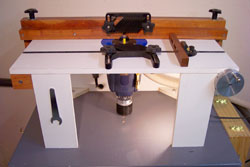by James Gavin

For those metalworkers who, like me, also indulge in the hobby of woodworking, there is often a desire to carry the processes used in precision machining into the wood shop. Router tables equipped with high-speed routers, routinely used to machine grooves and various molding cross-sections in wood, lack the precision found in metalworking machines such as milling machines and lathes, although some recent designs have offered means of adjusting router bit depth to a few thousandths of an inch. However, no currently available router tables, to my knowledge, offer the capability of adjusting the fence position relative to the router bit in thousandths of an inch. While they may provide scales in fractional inch increments to set the fence manually, a woodworker must fall back on “cut-and-try” techniques to achieve accuracy in thousandths. It has been my experience that if wooden parts are machined accurately, assembly is much easier and fits are more predictable. Also, working in decimals is a lot easier than fractions, in my opinion.
In my previous article, “Micrometer Stop for a Miter Saw” (The Home Shop Machinist March/April 2007), I discussed the advantages of using metalworking techniques in woodworking and described the design and construction of a micrometer stop for a miter saw to enable wood to be cut to precise lengths. In this article, I will describe the design and construction of a precision router table that can be likened to a “milling machine for wood” (Photo 1). I will make many of the parts for this table from hardwood (cherry), which machines nicely and can be substituted for metals where stresses are not too high. Hardwoods are readily available at much lower prices than metals, and mistakes can often be repaired, whereas with metals, machining errors usually end up with the part in the scrap bin.
“Precision Router Table” appears in the March/April 2009 issue of The Home Shop Machinist.
